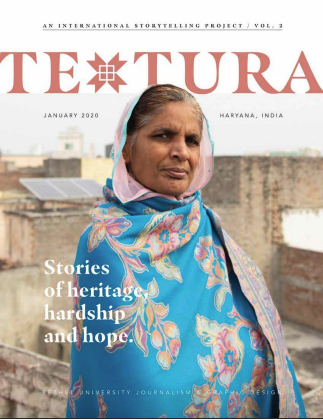
An International Storytelling Project
An International Storytelling Project
This is Inspired Journalism
Textura is a study abroad project envisioned by the Bethel University Journalism and Design departments and executed in collaboration with BU students and local teams at various international locations including Antigua, Guatemala (2017, 2022) and Haryana, India (2020, 2024). View the most recent project online, here, and don’t forget to check out the magazine and documentary content! Thanks for visiting.
Click to download PDFs of the most recent and past magazine:
Volume 4 - 2024
Volume 3 - 2022
Volume 2 - 2020
Volume 1 - 2017
Welcome to Haryana, India…
Home is wherever I’m Lost
By Kumar “Rafi” Abhimanyu
Photo by Maya Phillips
My grandparents migrated to Haryana during the partition of India in 1947. My paternal grandparents speak Jhangi and the maternals speak Multani, different versions of Punjabi. As for me, I was raised in Haryana, stranded from either of the languages. I know one of the few versions of Haryanvi and I can read Telugu and Kannada too. I studied English in institutions but my mother tongue is Hindi. My music taste lies in all languages — or rather, the language doesn’t matter. I have embodied different cultures through people and their words.
Kumar “Rafi” Abhimanyu walks fields outside the village of Titram in the Kaithal district that he saw with new eyes as a reporting partner for Textura India 2024. | Photo by Anna Pearson
Every person here carries a different history and culture in their body and beings, yet they all belong to Haryana. While constantly trying to put a label on our identities, we forget India is a hybrid culture. We try to look for purity in identities, which fails as an idea even before it buds.
Where do I belong? Is it on the outskirts of Titram, a village in northwest India — the home I left about 10 years ago? Or is it Delhi, the city that taught me to fight for our rights? Or is it Mumbai, where I act, dance and make my bread? My language has changed. So have my lifestyle and friends. I fit everywhere, yet nowhere at all.
While leading a team of people from a different country with an altogether different culture, I had all kinds of doubts: Will they understand the context, the emotions and the subtext of what their sources say? Will I be able to translate all the pauses and silences?
There’s a saying in Haryana that our dialect changes every 10 miles and new words come into play in daily practices. As language changes, culture does too. You can tell a person’s hometown region by just knowing if they say ‘कड़े’ (kade) or ‘कित’ (kit), both meaning, “Where?” While talking about Haryana to my friends in Delhi and Mumbai, I have always described it as green ... or yellow, depending on the season. We thrive on sweets and dairy products. We have a strong sense of community and our festivals sew our social threads together.
Our vocabulary is rich but our words fall short. We have different words for the word “achha” — “good” — and all of them taste different on the tongue. The word can mean other things: “fine,” “okay,” “like.” Confusing, right? And if you add a nod or a punctuation, it’s an altogether different game of interpreting it that only we understand.
Even though I have known this place and its people since my birth, meeting people during this project was a revelation to me. I saw individuals fight for their beliefs and assert themselves and their identity — not just social and cultural but personal, too — in the larger scheme of justice. In this small radius of 6 miles, many of the working-class migrant people are trying to find a home in a place far away from their own homes. Some are trying to leave Haryana to make a new one in the West. And some, mostly women, are trying to find a sense of belonging within their own homes.
Going back home took me places. My hometown, like every other city, is not a unified region painted by just one color, much like our identities. Haryana is a lot of things and locating oneself within it is even more difficult. So, where do I belong? Maybe the answer doesn’t lie in knowing a place but in revisiting it again and again and rediscovering yourself.







